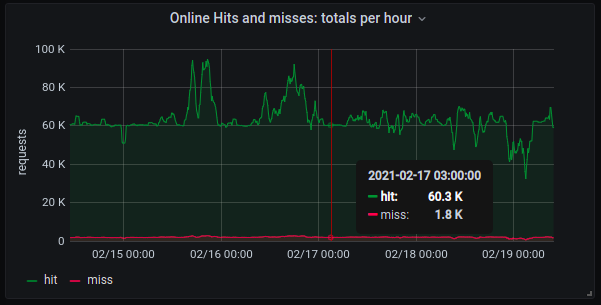GitHub Mirror
GitHub API mirror that caches the responses and implements conditional requests.
With conditional requests, all the calls are forwarded to the Github API, but when the GitHub API replies with a 304 HTTP code, meaning that the resource has not changed, we serve the client with the previously cached response.
That reduces the number of API calls that consume quota, helping you not to hit the API GitHub API rate limit.
The mirror acts only on GET requests, by-passing other HTTP methods.
The default cache backend is in-memory, and we also support Redis. The in-memory cache is shared among all the threads, but not shared between processes. Every time the server is started, the cache is initialized empty. Using Redis prevents the cache from being lost when the github mirror server is restarted.
Quick Start
Run the Docker container:
~$ docker run --rm -it -p 8080:8080 quay.io/app-sre/github-mirror
[2021-02-20 12:40:16 +0000] [1] [INFO] Starting gunicorn 20.0.4
[2021-02-20 12:40:16 +0000] [1] [INFO] Listening at: http://0.0.0.0:8080 (1)
[2021-02-20 12:40:16 +0000] [1] [INFO] Using worker: threads
[2021-02-20 12:40:16 +0000] [8] [INFO] Booting worker with pid: 8
Use it as the Github API url:
>>> import requests
>>>
>>> requests.get('http://localhost:8080/repos/app-sre/github-mirror')
<Response [200]>
>>>
>>> requests.get('http://localhost:8080/repos/app-sre/github-mirror')
<Response [200]>
>>>
After those two requests, the server log will show:
2020-02-16 21:08:07,948 [GET] CACHE_MISS https://api.github.com/repos/app-sre/github-mirror
2020-02-16 21:08:13,585 [GET] CACHE_HIT https://api.github.com/repos/app-sre/github-mirror
The second request was served from the cache and it did not consume the API calls quota.
If you're using PyGithub, you have to pass the base_url when creating the
client instance:
>>> from github import Github
>>> gh_cli = Github(base_url='http://localhost:8080')
Redis Cache Backend
To enable the Redis backend, set the environment variable:
CACHE_TYPE=redis
In addition to that, you can provide the following optional configuration:
PRIMARY_ENDPOINTis the primary endpoint or host address of the Redis service. If not set, it defaults tolocalhost.READER_ENDPOINTis the read-only replica endpoint and can be used to increase the read availability of the Redis service. If not set, it defaults to the same address as the primary endpoint.REDIS_PORTis the port which the Redis service binds to. The default port is6379.REDIS_PASSWORDis the authentication token to access a password protected Redis server. If not set, the default is no authentication.REDIS_SSLshould be set toTrueif you are encrypting the traffic to the Redis server. If not set, the default assumes no encryption.
You will find more details about the Redis cache backend implementation in the Redis Cache Backend doc.
Metrics
The service has a /metrics endpoint, exposing metrics in the Prometheus
format:
>>> response = requests.get('http://localhost:8080/metrics')
>>> print(response.content.decode())
...
http_request_total 2.0
...
request_latency_seconds_count{cache="MISS",method="GET",status="200"} 1.0
...
request_latency_seconds_count{cache="HIT",method="GET",status="200"} 1.0
...
With that, as the Github API rate limit is per hour, you can have the total HIT/MISS per hour with:
sum(increase(request_latency_seconds_count{endpoint="github-mirror",cache="ONLINE_HIT"}[1h]))
and
sum(increase(request_latency_seconds_count{endpoint="github-mirror",cache="ONLINE_MISS"}[1h]))
Plotting on Grafana, we have:
Many more metrics are available. Check the /metrics endpoint for details.
User Validation
To enable the user validation, the GITHUB_USERS environment variable
should be available to the server. The GITHUB_USERS is a colon-separated
list of authorized users to have their requests to the Github Mirror served.
Example:
GITHUB_USERS=app-sre-bot,quay-io-bot
The user validation, when enabled, will not allow unauthenticated requests to the Github Mirror.
Please notice that, in order to validate the user, one additional get request
is made to the Github API, to the /user endpoint, using the provided
authorization token. That call will also go through the caching mechanism, so
the rate limit will be preserved when possible.
Offline Mode
There's a built-in mechanism to detect when the Github API is offline.
To do so, we have a separate thread that keeps checking the url
https://api.github.com/status every second. When we don't get a success
response, we consider the Github API offline.
When that happens, all the requests are served from the cache until we detect that the Github API is back online.
Requests served from the cache when we are in offline mode will be accounted for in separate metrics:
request_latency_seconds_count{endpoint="github-mirror",cache="OFFLINE_HIT"}
and
request_latency_seconds_count{endpoint="github-mirror",cache="OFFLINE_MISS"}
Contributing
For contributing to the project, please follow the Development Guide.
